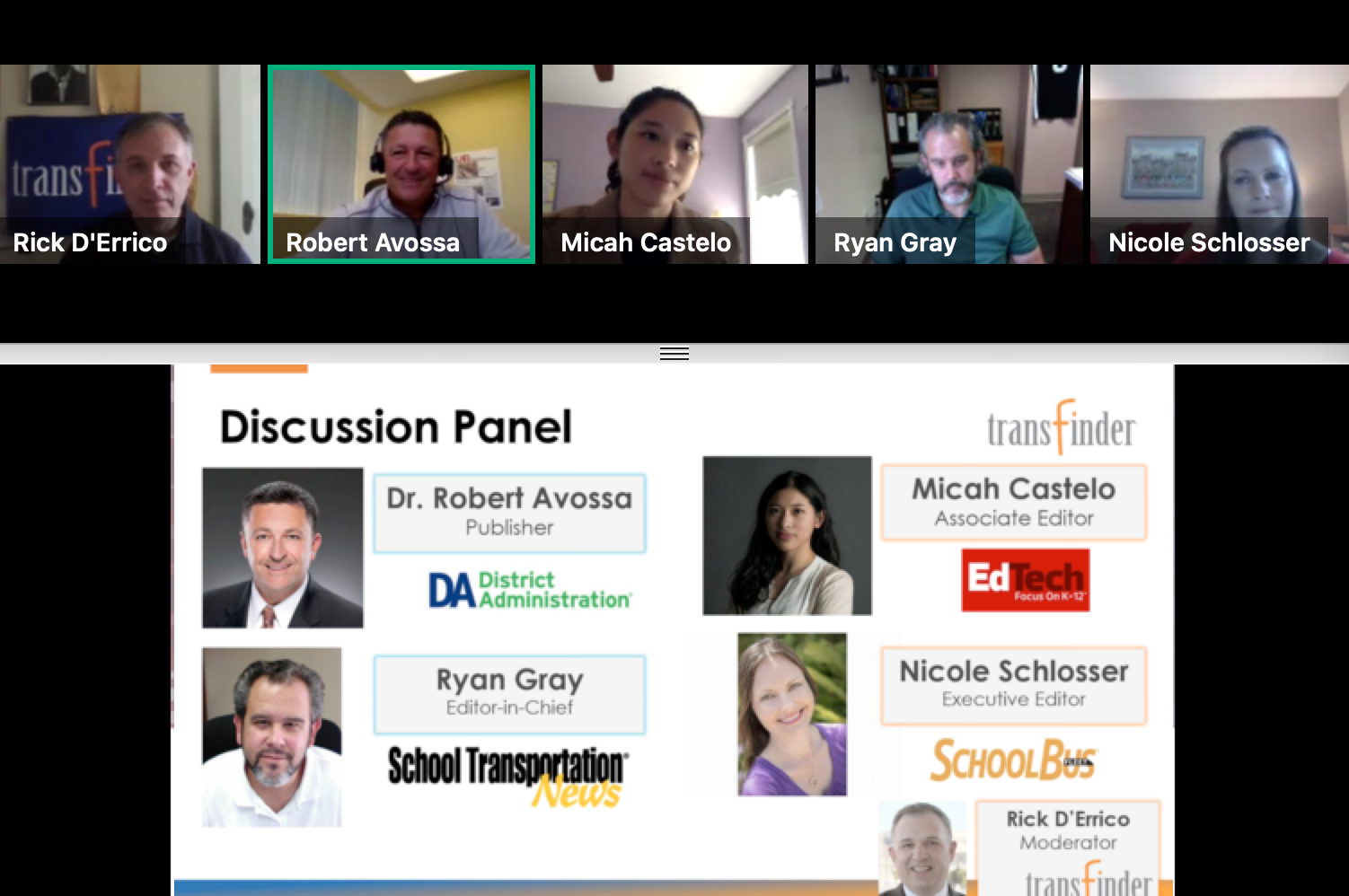The million-dollar question remains: What does the school experience look like after the coronavirus pandemic, and what will it mean for student transportation?
In a webinar on Thursday produced by Transfinder, media professionals who cover the education and student transportation industries provided insight on how COVID-19 is affecting operations and employees, and they shared what life may look like when the dust settles.
As School Transportation News previously reported, Los Angeles Unified School District announced the 2020-2021 school year will start on Aug. 18. However, Superintendent Austin Beutner said it remains unknown if students will be returning to the normal classroom.
Related: California Student Transporters Gear Up for Potential Early School Year Start
Many administrators across the nation have shared they are looking at a hybrid model of both online and in-person learning, where groups of students would be divided in half, with five days of in-person learning stretched across a two-week span.
Ryan Gray, editor-in-chief of School Transportation News, said that for some school districts it might make more sense to go back to school as “normal,” if they have not had many COVID-19 cases in that area.
For instance, Montana Gov. Steve Bullock announced schools have the option to start in-person learning as soon as Thursday. As of this report, the state had only 456 confirmed cases, or three-tenths of one percent of all cases nationwide, with 417 of those patients fully recovering. The state has also seen 16 confirmed deaths.
Robert Avossa, publisher of District Administration magazine, which covers the K-12 educational system, said Florida administrators are allowing parents to decide whether their students get held back a grade next school year. He noted that in normal circumstances, parents would need to request their child be held back via a school board review. However, this year parents have sole discretion. He noted that Florida is the only state he has seen with this allowance.
From a technology standpoint, Micah Castelo, the associate editor for Ed Tech magazine, said that school districts are able to track students who need the most support, adding that during this time administrators are able to monitor engagement. She said they can see what kids don’t get online, and which might need additional help.
When discussing what the future of education looks like, Avossa and Castelo discussed how different types of students and their learning preferences will thrive in different environments.
With districts investing money into eLearning practices, such as Chromebook and Wi-Fi routers, Gray questioned if school districts will place more of an emphasis on eLearning going forward.
Avossa noted that even though the Coronavirus Aid, Relief, and Economic Security (CARES) ACT grants public K-12 school districts $15 billion for online education infrastructure, the funds are stretched thin across the nation. He noted that not all districts will have the resources they need for distance learning. However, he said this is the perfect time for districts to be strategic during the pandemic and look at what type of schooling will be best going forward.
Whether that will be all in-person learning, a full online learning module, or a hybrid model remains to be seen. However, he noted online learning could help teachers catch up with the kids who have been traditionally left behind because they didn’t have access to that one-on-one environment.
Castelo said it’s important when discussing an online distance learning module for teachers to not focus on reviewing content, but instead coming up with new lesson plans and curriculum so students can further their education and have a full eight-hour day of learning.
Nicole Schlosser, the executive editor of School Bus Fleet magazine, said if the new normal becomes an online distance learning model for some of the students, at least partially, it could help alleviate or even be a solution to the ongoing school bus driver shortage. But many drivers are also in the at-risk category based on their ages or medical conditions, they might not want to continue being a school bus driver, which could inherently make the shortage situation worse. However, online learning could essentially help fill that gap, she noted.

While many are attempting to look at the positive side of the sky-high unemployment rates, noting that the 2008 recession helped the school bus driver shortage, Gray said the bottom line is pay. He said school bus drivers aren’t paid enough for the work that they do.
He noted the best way to keep drivers is by having a positive work-based culture, but school bus drivers still have to support their families and build a career. He noted that just because recessions and high unemployment worked in the past to reduce driver shortages, doesn’t mean they are going to work now. Instead, he advised districts to be proactive and be competitive in pay.
Avosso noted that as superintendent of the School District of Palm Beach County in Florida, school bus drivers were paid the highest of any in the area. That forced neighboring districts to raise their pay scales.
Rick D’Errico, public relations director at Transfinder, pointed out that some unemployment benefits are higher than what the drivers were actually getting paid during the school year.
One element of the coronavirus pandemic, Gray noted, is certain school districts not continuing to pay their contractors. He said the money is already budgeted for the current school year, and he was surprised at the number of school bus drivers without jobs, despite stipulations in the CARES Act and in various executive orders issued by governors.
He said attorneys are finding loopholes in the language that districts should continue paying “to the greatest extent possible.” He noted that one of the largest school bus contractors on Long Island recently shut its doors due to the pandemic and the lack of payment.
Related: New York School Bus Contractor Permanently Closes Doors Due to Coronavirus
Gray shared that school bus drivers are sharing their stories of hours being cut, or they are on unemployment. Some have confessed that although they have been a driver for years, they no longer want to return to work because of their frustration.
Schlosser agreed, adding that she has had similar conversations. She mentioned Corey Muirhead, the president of the New York School Bus Contractors Association, who has been a voice for contractors in the state as well as nationwide. He advocates for contractors and openly discusses how much behind the scenes work goes into being a driver, including drivers staying trained and certified.
Gray noted that school districts think they being smart now by not paying their contractors, but when schools open again, they are going to be without a school bus service, as contractors won’t be able to instantly start transporting students again.
D’Errico concluded, “The dust is going to settle.”
The webinar will be available on Transfinder’s Best Practices web page.














